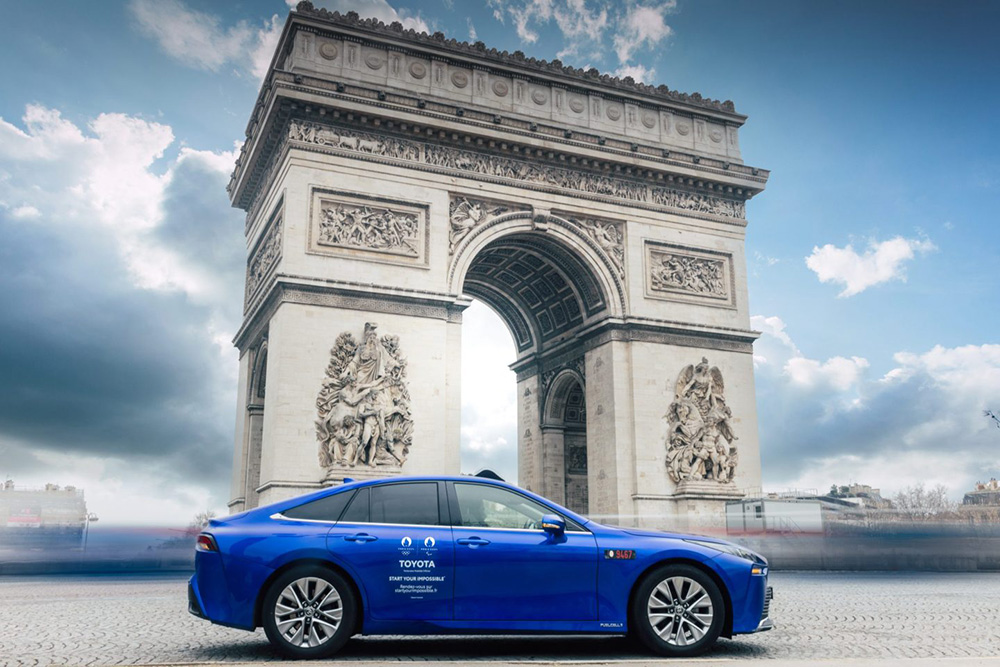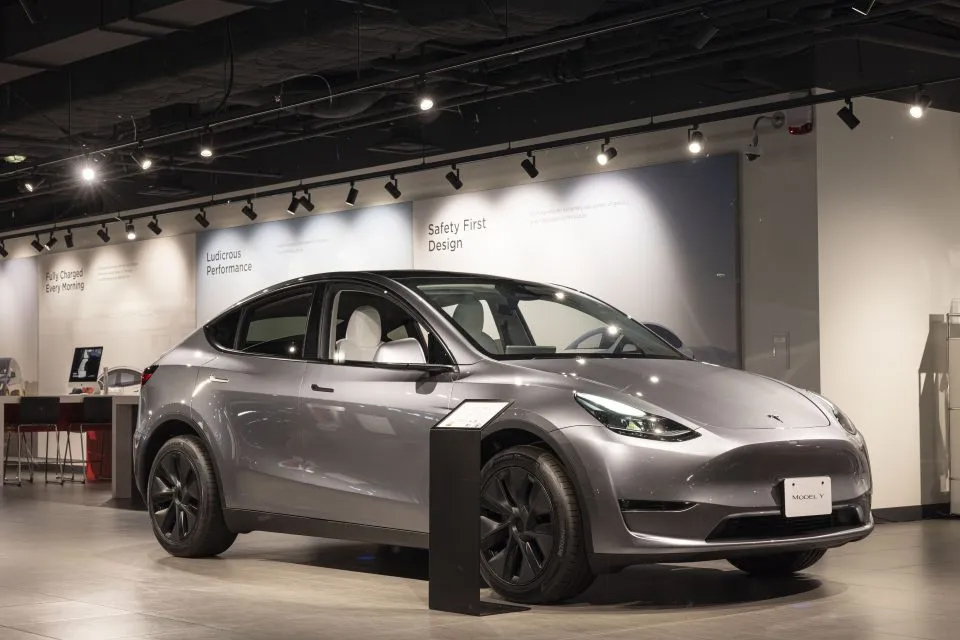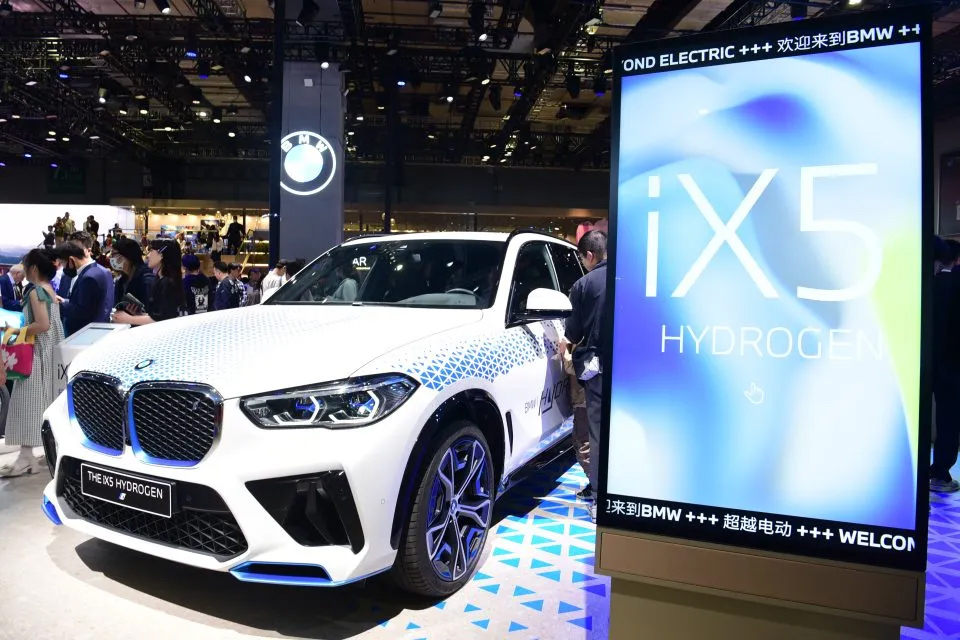
巴黎奥运会选择使用500辆丰田氢燃料电池汽车Mirai接送运动员,以展示奥运会的绿色环保理念。但是,美国和英国的120名科学家联名写信反对使用Mirai,并呼吁改用纯电动汽车,这是史无前例的。
像Mirai这样的氢燃料电池汽车实现了零二氧化碳尾气排放的可持续发展目标,而且可以在几分钟内加满燃料。那么,问题到底出在哪里呢?
欧盟在2024年春季对氢能产业的投资额达到2200000000欧元
这封投诉信是激烈辩论的最新一轮攻势,这场辩论几乎和美国总统选举一样充满争议。一方面,氢能的支持者声称他们所青睐的燃料是未来天然的脱碳能源,其生态系统类似于内燃机,而且加油时间短。
欧盟似乎也同意这一观点,仅在2024年春季就投入了22亿欧元的资金。另一方面,纯电动汽车已经开始大量销售,技术也在不断改进,基础设施也在不断完善。它们如今已经成为现实,而不是未来的希望。
丰田Mirai是最畅销的氢燃料电池汽车,但到2022年底,其全球销量仍仅为约2.2万辆。2023年,Mirai汽车仅售出2737辆,2024年上半年仅售出245辆。相比之下,全球最畅销的电动汽车(以及2023年所有燃料类型中最畅销的汽车)特斯拉Model Y在2023年售出了120万辆。
在美国,丰田公司正面临消费者的集体诉讼,他们声称,丰田公司以"氢气很容易获得"为幌子,误导他们购买Mirai。
2737对120万:2023年丰田Mirai与特斯拉Model Y电动车的销量对比
事实上,加氢站的数量一直在减少,壳牌(Shell)完全退出了加州的加氢站业务,而加州通常被认为是世界上对氢最友好的地区。
当壳牌宣布这一举措时,称氢泵难以获得氢气。这个故事在其他地方也很常见。法国全国只有五个氢泵,巴黎只有两个,这不禁让人怀疑为奥运会服务的汽车是在哪里加氢的。

与此形成鲜明对比的是,纯电动汽车充电网络不断扩大,例如,截至1月底,法国的公共充电点已超过12万个。
使用丰田Mirai被认为是巴黎奥运会成为有史以来最环保的奥运会的一部分,本届奥运会排放量将比往届减少一半。Mirai仍然是一辆由电动机驱动的电动汽车,但其主要能源是氢燃料电池。
这项技术将储存在高压罐中的氢气与空气中的氧气结合起来,从而产生电能。唯一的副产品是水,它会从汽车排入大气,因此不会排放二氧化碳。
然而,为了实现完全零排放,像Mirai这样的氢燃料电池汽车需要使用“绿”氢。这意味着氢必须通过使用零排放能源发电产生,最好是可再生能源。电能被用来电解水,把水分解成氢和氧,氢气被收集起来作为燃料使用。
那么,氢气真的是绿色的吗?
这就是氢气在个人交通以及其他各种应用中的争议所在。
目前全球可用的氢很少是绿色的。事实上,只有大约1%是绿色的。其余的氢气来自化石燃料,通常是通过甲烷气体的"蒸汽转化"产生的。这种氢被称为"灰"氢,在生产过程中会排放大量二氧化碳。由此产生的二氧化碳可以被捕获和封存,以制造"蓝"氢,但这种技术尚未得到证实,而且蓝氢甚至比绿氢更罕见。
如果氢燃料电池汽车是由灰氢驱动的,那么它就不是一种真正可持续的交通方式。从理论上讲,如果绿氢产量增加,它可以像电池一样实现零碳排放。但这是重大“假设”,即使是绿氢,也有其他注意事项。
氢的第二个问题是,像Mirai这样的电动汽车使用氢作为能源载体的效率非常低。利用电力从水中电解出氢,将其输送到输送泵,为汽车加注氢气,然后用氢气在车内发电为电动机提供动力的过程中,会损失大量的能量。
这比直接给电池充电和放电损失的能量要多得多。
如何运输氢是另一个问题。氢可能是一种丰富的元素,但分子太小,很难实现安全移动。
一种方法是将气体压缩到非常高的压力水平。丰田Mirai等氢燃料电池汽车装有凯夫拉尔(Kevlar)装甲油箱,可将氢气储存在700倍于地球大气压力的环境中,但这在大规模输送中很难做到。
另一种选择是使用液态储氢载体,氨和甲醇是主要的竞争者。但它们也有各自的缺点。氨具有极强的毒性和腐蚀性。甲醇和氨在生产过程中都会进一步增加耗能阶段,当它们储存的氢气被提取出来使用时,这一过程又会进一步降低效率。
为什么氢气仍在讨论之列?
这些都是120位科学家提出的关键问题,但他们并没有阻止一些机构继续关注氢的潜力。
宝马公司(BMW)仍在试验自己的氢燃料电池汽车,即2023年初推出的iX5 Hydrogen。该车是宝马X5 SUV的改装车,用于评估氢燃料电池汽车的可行性,而不是像丰田Mirai那样成为可供消费者购买的产品。

宝马正在继续扩大其电池电动汽车的范围,因此这只是一个对冲赌注。事实上,宝马电动汽车的销量相当不错。今年6月,宝马占据了英国电动汽车市场11%的份额,仅次于特斯拉。
Extreme E电动运动型多功能车系列赛车也将从电池动力转向氢动力。它将在2025年成为Extreme H,新车最近在苏格兰进行了测试。
在汽车行业纷纷转向电动汽车的时候,这一切似乎都是在错误的方向上迈出的一步,也受到了不少批评。但考虑到Extreme E与沙特阿拉伯能源行业的关系,这并不像看上去那么背道而驰。
尽管石油公司正在竭力维持全球能源生产和消费的化石燃料现状,但有些公司已经意识到“石油峰值"(化石燃料使用量达到峰值的时代)即将来临或已经过去。
明智的策略是利用石油行业的当前收入建立替代收入来源,而这似乎正是沙特阿拉伯正在尝试做的事情。作为“2030愿景”计划的一部分,该国计划到2030年安装的太阳能发电量约为其人口需求的三倍。剩余的部分将用于利用红海的水制氢,并销往全球。
与电池相比,氢气的效率问题是无法解决的。但它的相对定价则是另一回事,这又让我们回到了奥运会。
在2021年东京奥运会期间,氢使用的远大目标不得不大幅缩减。用氢气为奥运村供电的计划被放弃了。本届奥运会仍部署了500辆丰田Mirai汽车和100辆氢燃料巴士,但后者的使用尤其存在争议,原因是其燃料成本是柴油的2.6倍。
不过,像沙特阿拉伯这样的国家有可能安装大量可再生能源装置,然后以非常低廉的价格生产绿氢。这是否能使其在为电池电动汽车充电时与当地生产的电力竞争,还有待观察。
现在看来,在巴黎使用的丰田Mirai汽车看起来很可疑,像是在"漂绿"。但这表明,一些大企业和国家利益集团仍在极力确保氢气在讨论之列。
译者:中慧言-王芳
巴黎奥运会选择使用500辆丰田氢燃料电池汽车Mirai接送运动员,以展示奥运会的绿色环保理念。但是,美国和英国的120名科学家联名写信反对使用Mirai,并呼吁改用纯电动汽车,这是史无前例的。
像Mirai这样的氢燃料电池汽车实现了零二氧化碳尾气排放的可持续发展目标,而且可以在几分钟内加满燃料。那么,问题到底出在哪里呢?
欧盟在2024年春季对氢能产业的投资额达到2200000000欧元
这封投诉信是激烈辩论的最新一轮攻势,这场辩论几乎和美国总统选举一样充满争议。一方面,氢能的支持者声称他们所青睐的燃料是未来天然的脱碳能源,其生态系统类似于内燃机,而且加油时间短。
欧盟似乎也同意这一观点,仅在2024年春季就投入了22亿欧元的资金。另一方面,纯电动汽车已经开始大量销售,技术也在不断改进,基础设施也在不断完善。它们如今已经成为现实,而不是未来的希望。
丰田Mirai是最畅销的氢燃料电池汽车,但到2022年底,其全球销量仍仅为约2.2万辆。2023年,Mirai汽车仅售出2737辆,2024年上半年仅售出245辆。相比之下,全球最畅销的电动汽车(以及2023年所有燃料类型中最畅销的汽车)特斯拉Model Y在2023年售出了120万辆。
在美国,丰田公司正面临消费者的集体诉讼,他们声称,丰田公司以"氢气很容易获得"为幌子,误导他们购买Mirai。
2737对120万
2023年丰田Mirai与特斯拉Model Y电动车的销量对比
事实上,加氢站的数量一直在减少,壳牌(Shell)完全退出了加州的加氢站业务,而加州通常被认为是世界上对氢最友好的地区。
当壳牌宣布这一举措时,称氢泵难以获得氢气。这个故事在其他地方也很常见。法国全国只有五个氢泵,巴黎只有两个,这不禁让人怀疑为奥运会服务的汽车是在哪里加氢的。
与此形成鲜明对比的是,纯电动汽车充电网络不断扩大,例如,截至1月底,法国的公共充电点已超过12万个。
使用丰田Mirai被认为是巴黎奥运会成为有史以来最环保的奥运会的一部分,本届奥运会排放量将比往届减少一半。Mirai仍然是一辆由电动机驱动的电动汽车,但其主要能源是氢燃料电池。
这项技术将储存在高压罐中的氢气与空气中的氧气结合起来,从而产生电能。唯一的副产品是水,它会从汽车排入大气,因此不会排放二氧化碳。
然而,为了实现完全零排放,像Mirai这样的氢燃料电池汽车需要使用“绿”氢。这意味着氢必须通过使用零排放能源发电产生,最好是可再生能源。电能被用来电解水,把水分解成氢和氧,氢气被收集起来作为燃料使用。
那么,氢气真的是绿色的吗?
这就是氢气在个人交通以及其他各种应用中的争议所在。
目前全球可用的氢很少是绿色的。事实上,只有大约1%是绿色的。其余的氢气来自化石燃料,通常是通过甲烷气体的"蒸汽转化"产生的。这种氢被称为"灰"氢,在生产过程中会排放大量二氧化碳。由此产生的二氧化碳可以被捕获和封存,以制造"蓝"氢,但这种技术尚未得到证实,而且蓝氢甚至比绿氢更罕见。
如果氢燃料电池汽车是由灰氢驱动的,那么它就不是一种真正可持续的交通方式。从理论上讲,如果绿氢产量增加,它可以像电池一样实现零碳排放。但这是重大“假设”,即使是绿氢,也有其他注意事项。
氢的第二个问题是,像Mirai这样的电动汽车使用氢作为能源载体的效率非常低。利用电力从水中电解出氢,将其输送到输送泵,为汽车加注氢气,然后用氢气在车内发电为电动机提供动力的过程中,会损失大量的能量。
这比直接给电池充电和放电损失的能量要多得多。
如何运输氢是另一个问题。氢可能是一种丰富的元素,但分子太小,很难实现安全移动。
一种方法是将气体压缩到非常高的压力水平。丰田Mirai等氢燃料电池汽车装有凯夫拉尔(Kevlar)装甲油箱,可将氢气储存在700倍于地球大气压力的环境中,但这在大规模输送中很难做到。
另一种选择是使用液态储氢载体,氨和甲醇是主要的竞争者。但它们也有各自的缺点。氨具有极强的毒性和腐蚀性。甲醇和氨在生产过程中都会进一步增加耗能阶段,当它们储存的氢气被提取出来使用时,这一过程又会进一步降低效率。
为什么氢气仍在讨论之列?
这些都是120位科学家提出的关键问题,但他们并没有阻止一些机构继续关注氢的潜力。
宝马公司(BMW)仍在试验自己的氢燃料电池汽车,即2023年初推出的iX5 Hydrogen。该车是宝马X5 SUV的改装车,用于评估氢燃料电池汽车的可行性,而不是像丰田Mirai那样成为可供消费者购买的产品。
宝马正在继续扩大其电池电动汽车的范围,因此这只是一个对冲赌注。事实上,宝马电动汽车的销量相当不错。今年6月,宝马占据了英国电动汽车市场11%的份额,仅次于特斯拉。
Extreme E电动运动型多功能车系列赛车也将从电池动力转向氢动力。它将在2025年成为Extreme H,新车最近在苏格兰进行了测试。
在汽车行业纷纷转向电动汽车的时候,这一切似乎都是在错误的方向上迈出的一步,也受到了不少批评。但考虑到Extreme E与沙特阿拉伯能源行业的关系,这并不像看上去那么背道而驰。
尽管石油公司正在竭力维持全球能源生产和消费的化石燃料现状,但有些公司已经意识到“石油峰值"(化石燃料使用量达到峰值的时代)即将来临或已经过去。
明智的策略是利用石油行业的当前收入建立替代收入来源,而这似乎正是沙特阿拉伯正在尝试做的事情。作为“2030愿景”计划的一部分,该国计划到2030年安装的太阳能发电量约为其人口需求的三倍。剩余的部分将用于利用红海的水制氢,并销往全球。
与电池相比,氢气的效率问题是无法解决的。但它的相对定价则是另一回事,这又让我们回到了奥运会。
在2021年东京奥运会期间,氢使用的远大目标不得不大幅缩减。用氢气为奥运村供电的计划被放弃了。本届奥运会仍部署了500辆丰田Mirai汽车和100辆氢燃料巴士,但后者的使用尤其存在争议,原因是其燃料成本是柴油的2.6倍。
不过,像沙特阿拉伯这样的国家有可能安装大量可再生能源装置,然后以非常低廉的价格生产绿氢。这是否能使其在为电池电动汽车充电时与当地生产的电力竞争,还有待观察。
现在看来,在巴黎使用的丰田Mirai汽车看起来很可疑,像是在"漂绿"。但这表明,一些大企业和国家利益集团仍在极力确保氢气在讨论之列。
译者:中慧言-王芳
The Paris Olympics chose to use 500 hydrogen-powered Toyota Mirai cars to ferry athletes around and show off the green credentials of the games. But in an unprecedented move, a coalition of 120 scientists in the U.S. and U.K. have written a letter objecting to the Mirai’s use and called for battery-electric vehicles to be employed instead.
Hydrogen fuel cell cars like the Mirai fulfill the sustainability goal of having zero CO2 tailpipe emissions, and they can be refueled in minutes. So, what exactly is the problem?
€2,200,000,000
The amount the EU invested in the hydrogen industry in the spring of 2024
The letter of complaint is the latest salvo in a heated debate that is almost as fractious as the American election. On the one hand, hydrogen supporters claim their favorite fuel is the natural decarbonized energy source of the future, with an ecosystem similar to combustion engines and short refueling times.
The EU seems to agree, having invested €2.2 billion worth of funding in the spring of 2024 alone. On the other hand, battery electric vehicles are already selling in large numbers, the technology is improving, and its infrastructure growing. They are here now rather than a hope for the future.
The Toyota Mirai is the biggest-selling hydrogen fuel cell car, but it still only sold about 22,000 units globally by the end of 2022. There were only 2,737 Mirai cars sold in 2023, and just 245 in the first half of 2024. Compare that with the bestselling EV globally (and the bestselling car of any fuel type in 2023), the Tesla Model Y, which shifted 1.2 million units in 2023.
In the U.S., Toyota is facing a class action suit from a group of consumers who claim they were mis-sold the Mirai under the false pretense that hydrogen would be readily available.
2,737 vs. 1,200,000
The number of Toyota Mirai cars sold vs. Tesla Model Y EVs in 2023
In fact, the number of hydrogen fueling stations has been shrinking, with Shell pulling out of the business entirely in California, generally considered the most hydrogen-friendly region in the world.
When Shell announced the move, the company cited difficulties obtaining hydrogen for its pumps. It’s a familiar story elsewhere. France has only five hydrogen pumps for the whole country, and just two in Paris, which does prompt the question of where the cars serving the Olympics are being refueled.
In contrast, the battery EV charging network continues to expand, with over 120,000 public charge points in France at the end of January, for example.
Using the Toyota Mirai is supposed to be part of how the Paris Olympics becomes the greenest ever, halving its emissions compared with previous games. The Mirai is still an electric car, driven by an electric motor, but its primary energy source is a hydrogen fuel cell.
This technology combines hydrogen gas stored in a high-pressure tank with oxygen taken from the air in a process that generates electrical power. The only side product is water, which is expelled from the vehicle into the atmosphere. No CO2 is therefore emitted.
However, to be fully emissions-free, a hydrogen fuel cell vehicle like the Mirai needs to use “green” hydrogen. This means the hydrogen must be generated by using electricity from a zero-emission energy source, preferably renewables. The electrical energy is used to electrolyze water, separating it into its constituent hydrogen and oxygen. The hydrogen is then collected for use as a fuel.
So is hydrogen really green?
This is where the controversy begins with hydrogen’s employment for personal transportation, and indeed for every other application.
Very little of the hydrogen currently available globally is green. In fact, only about 1% is. The rest is generated from fossil fuels, usually via “steam reforming” of methane gas. This is called “gray” hydrogen and has significant CO2 emissions during the production process. The resultant CO2 can be captured and stored to make “blue” hydrogen, but that technology isn’t proven, and blue hydrogen is even less common than green.
If a hydrogen fuel cell car is powered by gray hydrogen, it’s not really a sustainable form of transport. Theoretically, it could be zero carbon like batteries, if green hydrogen production ramps up. But that’s a big “if,” and there are other caveats even when the hydrogen is green.
The secondary problem with hydrogen comes from the fact that using hydrogen as an energy carrier for an electric car like the Mirai is very inefficient. A lot of energy is lost in the process of electrolyzing hydrogen from water using electricity, transporting it to the delivery pump, filling the vehicle, then using it to generate electricity in the vehicle to power an electric motor.
Much more energy is lost than charging and discharging a battery directly.
How you transport hydrogen is another of its problems. It may be an abundant element, but the molecules are so small they are very hard to move around safely.
One way is to compress the gas to very high levels. Hydrogen fuel cell cars like the Toyota Mirai contain Kevlar-armored tanks that store hydrogen at 700 times the pressure of the Earth’s atmosphere. But this is hard to do on a large scale for distribution.
Another option is to use a carrier liquid, with ammonia and methanol being two of the main contenders. But they have their own drawbacks. Ammonia is extremely toxic and corrosive. Both methanol and ammonia add further energy-consuming stages during their production, and when the hydrogen they store is extracted for use, the process further reduces efficiency.
Why is hydrogen still on the table?
These are the key issues the 120 scientists have raised, but they haven’t deterred some organizations from remaining interested in hydrogen’s potential.
BMW is still experimenting with its own hydrogen fuel cell car, the iX5 Hydrogen, launched at the beginning of 2023. This is an adaptation of the BMW X5 SUV and is being used to assess the viability of hydrogen fuel cell cars, rather than being a product available for consumer purchase, like the Toyota Mirai.
BMW is continuing to expand its range of battery electric vehicles, so this is merely a hedging of bets. In fact, BMW’s EVs are selling quite well. In the U.K. in June, BMW had 11% of the EV market, second only to Tesla.
Electric SUV racing series Extreme E is also switching from batteries to hydrogen power for its race vehicles. It will become Extreme H in 2025, with the new car undergoing testing recently in Scotland.
This all seems like a move in the wrong direction, when the automotive industry is shifting to EVs, and it has received quite a bit of criticism. But it’s not as contrary as it looks, considering the connections Extreme E has to the Saudi Arabian energy industry.
As hard as oil companies are fighting to maintain the fossil fuel status quo for energy production and consumption globally, some realize that “peak oil” (the era of maximum fossil fuel usage) is close or has already passed.
The sensible strategy is to leverage current income from the oil industry to build an alternative income stream, and that appears to be what Saudi Arabia is trying to do. The country is planning to install around three times as much solar energy production by 2030 as its population needs, as part of its Vision 2030 plan. Some of the surplus will then be used to generate hydrogen with water from the Red Sea, which can be sold globally.
There’s no way the efficiency problems of hydrogen compared with batteries can be fixed. But its relative pricing is a different matter, which brings us back to the Olympics.
During the Tokyo Olympics in 2021, big intentions for hydrogen had to be scaled back considerably. Plans to power the Olympic village with hydrogen were dropped. The games still deployed 500 Toyota Mirai cars and 100 hydrogen buses, but the latter’s use was particularly controversial, with the fuel costing 2.6 times as much as diesel.
However, it’s possible that countries like Saudi Arabia can install huge renewable surplus and then produce green hydrogen very cheaply. Whether this can make it competitive with locally produced electricity to charge battery EVs remains to be seen.
Right now, the Toyota Mirai vehicles used in Paris look suspiciously like greenwashing. But it shows that there are some big corporate and national interests that are still trying very hard to keep hydrogen on the table.






